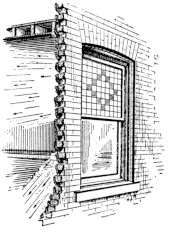Prism lighting
Refraction and total internal reflection inside optical prisms can bend beams of light.
[8][7] Daylight redirecting window film (DRF) is a thin, flexible peel-and-stick sheet, with the optical layer generally made of acrylic.
Some film is moulded with tiny prisms, making a flexible peel-and-stick miniature prismatic panel.
Other film is moulded with thin near-horizontal voids protruding into or through the acrylic; the slits reflect light hitting their top surfaces upwards.
[2] The reflection-based films are more transparent (both are translucent), but they tend to send the light up at the ceiling, not deeper into the room.
[1] Sidewalk prisms were cast in one piece as single or multiple-prism lenses, and inserted into load-bearing frames.
[citation needed] The removal or covering of old prism transom lights often leaves characteristically tall signage spaces over shop windows (see pictures).
[13] Some daylight redirecting films reflect incoming light upwards off tiny near-horizontal reflectors, so at high sun angles they bend it sharply, throwing it upwards to the ceiling, where a typical ceiling diffuses the daylight somewhat deeper into the space.
[9] Other daylight redirecting films refract light at any specified angle, ideally sending it nearly horizontally into the room.
